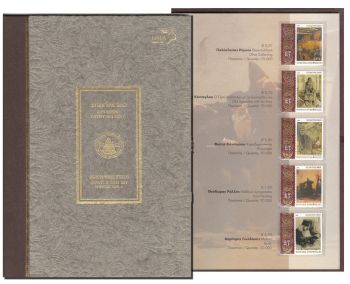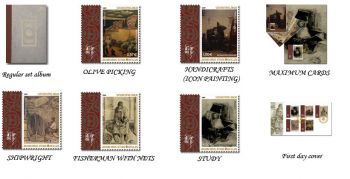Greece - Agion Oros Athos (Aspects of Every Day Spiritual Life C) 2009
Item details
| Price: | 50 € |
| Grade: | UNC - Uncirculated |
| Add to cart: | Quantity: |
Item description
1. STUDY
Study is a necessary part of all monks’ daily routine, contributing to their spiritual training and support. In addition to praying and reading communally during church services and at the altar, the monks also pray and study alone in their cells, where they perform their prayer rules and noetic prayer and immerse themselves in holy scripture, as well as other uplifting spiritual texts. Favourites include The Ladder of Divine Ascent by St John of Sinai, The Philokalia (containing writings by ascetic fathers), and The Gerontika. The monasteries have always made sure that their libraries were stocked with such works, whether printed or in manuscript, in order that monks can borrow them for their study.
The life of a monk is a continuing journey of spiritual progress and salvation. The word of God and the Church Fathers is always central to this journey and constitutes its guiding principle.
2. HANDICRAFTS (ICON PAINTING)
Icon painting is the handicraft practiced most widely among the monks of Mount Athos, particularly those who live in cells. Less commonly, it may also be an allotted task in communal monasteries if a monk possesses the specific talent. With many centuries of tradition, the Athonite “houses” of religious painting were renowned both on Mount Athos and beyond, meeting the constant demand for works of devotional and religious art.
Following long Byzantine tradition or sometimes influenced by Nazarene painting, Athonite painters were an important point of reference in the history of Orthodox ecclesiastical painting. The secrets of how to make portable icons and the history of the churches and chapels were passed on from generation to generation of monks. There are brotherhoods on Mount Athos which have many decades of history of icon painting.
3. OLD APOSTOLOS WITH HIS LINES
Fish plays a central role in the diet of the monks of Mount Athos, since traditionally they are not allowed to eat meat, and also because the Athonite monasteries lie close to the sea, which has always been a source of food. Even today, all the monasteries and some of the cells have their own fishing boats. These are kept in a special part of the monastery dockyards (arsanades), together with equipment such as nets and trawling lines.
Because fishing requires specialist knowledge, the task is usually assigned to one monk, who is sometimes assisted by two or three others. The same monk is also responsible for preparing the equipment before each fishing trip.
4. SHIPWRIGHT
Ever since the monastic state of Mount Athos was founded, the sea has been the chief means by which it has communicated with the outside world. Transportation of monks and pilgrims, chiefly to monastic dependencies of Athonite monks outside Mount Athos, used to take place mainly by boat. The dependencies also supplied the monasteries with the products necessary for the preparation of food (including grain, oil and dairy produce).
Some monasteries had their own craft for these longer journeys. These were kept in the monastery dockyards (arsanades), where the repair and maintenance of wooden hulls also took place. The shipwright who carried out this work could be either a monk or layperson. Repairs were also made on the smaller boats that were used for fishing.
5. OLIVE COLLECTING
As in other parts of the Mediterranean, olive picking on Mount Athos takes place in autumn. Because olive oil is a basic ingredient of the monks’ diet, the monasteries cultivate olive trees both on Mount Athos and in their dependencies. The extraction of the oil is thus the culmination of a series of tasks that begins with picking.
Olive picking lasts several days. It is often performed by all the monks of the monastery working together. The olives are then transferred to presses (or in the old days, to mills), whereupon the oil is extracted and stored in large stone jars in the monastery’s docheio (oil store).
Monastery of Megisti Lavra, Polykleitos Rengos, egg tempera, 1939
(Collection of the Municipal Gallery of Thessaloniki).
OLIVE COLLECTING
Monastery of Megisti Lavra, Polykleitos Rengos, egg tempera, 1939
(Collection of the Municipal Gallery of Thessaloniki)
OLD APOSTOLOS WITH HIS LINES
Old Apostolos with his lines, Kapsokalyvia, Fotis Kontoglou, ink drawing, 1923
(Private Collection)
SHIPWRIGHT
Shipwright, Cave of Agios Neilos, (Dockyard) Fotis Kontoglou, ink drawing, 1923. (Private Collection)
HANDICRAFTS (ICON PAINTING)
Icon painter on Mount Athos, Theodoros Rallis, oil on canvas (study), 1885
(Private Collection)
STUDY
Monk at study, Dimitris Gioldasis, pencil drawing, 1926
(Collection of the Municipal Gallery of Karditsa)
Study is a necessary part of all monks’ daily routine, contributing to their spiritual training and support. In addition to praying and reading communally during church services and at the altar, the monks also pray and study alone in their cells, where they perform their prayer rules and noetic prayer and immerse themselves in holy scripture, as well as other uplifting spiritual texts. Favourites include The Ladder of Divine Ascent by St John of Sinai, The Philokalia (containing writings by ascetic fathers), and The Gerontika. The monasteries have always made sure that their libraries were stocked with such works, whether printed or in manuscript, in order that monks can borrow them for their study.
The life of a monk is a continuing journey of spiritual progress and salvation. The word of God and the Church Fathers is always central to this journey and constitutes its guiding principle.
2. HANDICRAFTS (ICON PAINTING)
Icon painting is the handicraft practiced most widely among the monks of Mount Athos, particularly those who live in cells. Less commonly, it may also be an allotted task in communal monasteries if a monk possesses the specific talent. With many centuries of tradition, the Athonite “houses” of religious painting were renowned both on Mount Athos and beyond, meeting the constant demand for works of devotional and religious art.
Following long Byzantine tradition or sometimes influenced by Nazarene painting, Athonite painters were an important point of reference in the history of Orthodox ecclesiastical painting. The secrets of how to make portable icons and the history of the churches and chapels were passed on from generation to generation of monks. There are brotherhoods on Mount Athos which have many decades of history of icon painting.
3. OLD APOSTOLOS WITH HIS LINES
Fish plays a central role in the diet of the monks of Mount Athos, since traditionally they are not allowed to eat meat, and also because the Athonite monasteries lie close to the sea, which has always been a source of food. Even today, all the monasteries and some of the cells have their own fishing boats. These are kept in a special part of the monastery dockyards (arsanades), together with equipment such as nets and trawling lines.
Because fishing requires specialist knowledge, the task is usually assigned to one monk, who is sometimes assisted by two or three others. The same monk is also responsible for preparing the equipment before each fishing trip.
4. SHIPWRIGHT
Ever since the monastic state of Mount Athos was founded, the sea has been the chief means by which it has communicated with the outside world. Transportation of monks and pilgrims, chiefly to monastic dependencies of Athonite monks outside Mount Athos, used to take place mainly by boat. The dependencies also supplied the monasteries with the products necessary for the preparation of food (including grain, oil and dairy produce).
Some monasteries had their own craft for these longer journeys. These were kept in the monastery dockyards (arsanades), where the repair and maintenance of wooden hulls also took place. The shipwright who carried out this work could be either a monk or layperson. Repairs were also made on the smaller boats that were used for fishing.
5. OLIVE COLLECTING
As in other parts of the Mediterranean, olive picking on Mount Athos takes place in autumn. Because olive oil is a basic ingredient of the monks’ diet, the monasteries cultivate olive trees both on Mount Athos and in their dependencies. The extraction of the oil is thus the culmination of a series of tasks that begins with picking.
Olive picking lasts several days. It is often performed by all the monks of the monastery working together. The olives are then transferred to presses (or in the old days, to mills), whereupon the oil is extracted and stored in large stone jars in the monastery’s docheio (oil store).
Monastery of Megisti Lavra, Polykleitos Rengos, egg tempera, 1939
(Collection of the Municipal Gallery of Thessaloniki).
OLIVE COLLECTING
Monastery of Megisti Lavra, Polykleitos Rengos, egg tempera, 1939
(Collection of the Municipal Gallery of Thessaloniki)
OLD APOSTOLOS WITH HIS LINES
Old Apostolos with his lines, Kapsokalyvia, Fotis Kontoglou, ink drawing, 1923
(Private Collection)
SHIPWRIGHT
Shipwright, Cave of Agios Neilos, (Dockyard) Fotis Kontoglou, ink drawing, 1923. (Private Collection)
HANDICRAFTS (ICON PAINTING)
Icon painter on Mount Athos, Theodoros Rallis, oil on canvas (study), 1885
(Private Collection)
STUDY
Monk at study, Dimitris Gioldasis, pencil drawing, 1926
(Collection of the Municipal Gallery of Karditsa)
Shipping details
Shop location: Greece, Athens - P. Faliro
| Destination | Service | Cost (EUR) | Each additional item cost (EUR) |
|---|---|---|---|
| Greece | Local Pickup | 0 | 0 |
| Greece | First class mail international | 5 | 0 |
| Worldwide | To be determined | 0 | 0 |












